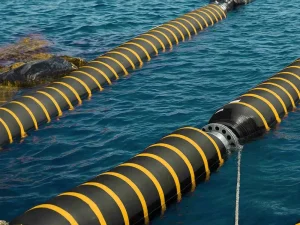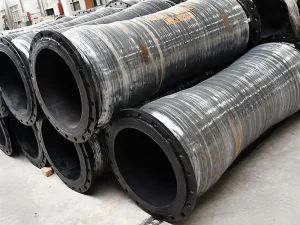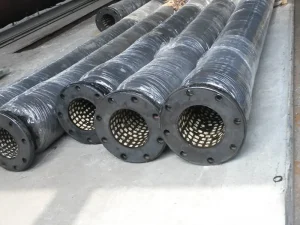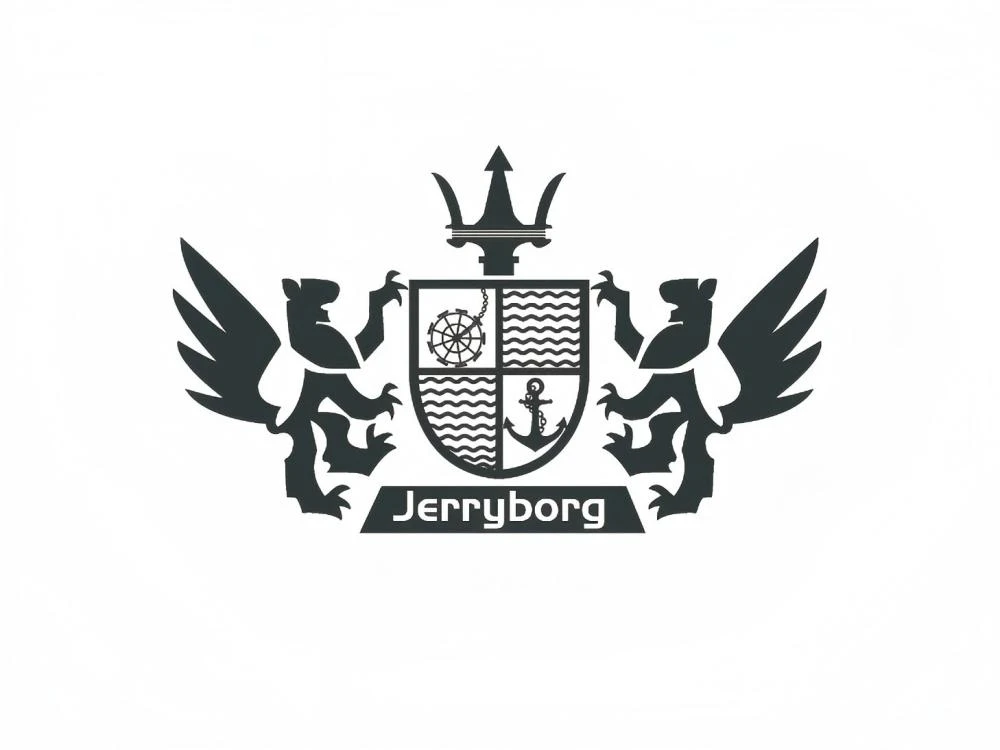Приступая к дноуглубительным работам, многие новички задаются вопросом: что такое дноуглубительный шланг и почему он так важен? Дноуглубительные работы являются неотъемлемой частью морских, горных и строительных проектов. Она включает в себя перемещение песка, ила, гравия и других материалов из одного места в другое. Чтобы сделать этот процесс плавным и безопасным, промышленные предприятия полагаются на шланги для дноуглубительных работ.
Эти шланги специально созданы для работы с прочными материалами и в суровых условиях. Однако шланги для земснарядов бывают разных типов, каждый из которых предназначен для удовлетворения конкретных потребностей. Понимание этих шлангов и принципов их работы поможет вам выбрать надежный вариант для вашего проекта. Поэтому, чтобы облегчить вам задачу, в этой статье я расскажу все о шлангах для земснарядов. Итак, давайте начнем!
Что такое дноуглубительный шланг? Краткий обзор!

Давайте сначала обсудим, что именно представляет собой дражный шланг!
Дноуглубительный шланг - это прочный и гибкий резиновый шланг. Он используется для перемещения песка, ила, шлама, гравия и других материалов во время дноуглубительных работ. В основном, дноуглубительные шланги соединяют земснаряды с трубопроводами. Таким образом, они помогают безопасно и беспрепятственно перемещать извлеченные материалы из одного места в другое.
Проще говоря, она действует как транспортный туннель для подводных материалов. На самом деле, при дноуглубительных работах несколько машин извлекают песок или ил со дна моря. Эти материалы необходимо доставить с места работы в нужные места, например, на берег или на строительную площадку. Но, как известно, эти материалы жесткие, и обычные шланги могут износиться при работе с ними. Вот тут-то и приходят на помощь шланги для дноуглубительных работ. Эти шланги имеют специальную конструкцию, которая обеспечивает безопасную транспортировку тяжелых материалов.
Как изготавливаются шланги для дноуглубительных работ?
Как я уже говорил выше, во время дноуглубительных работ в воду попадают песок, шлам и грязь. Чтобы справиться с этими тяжелыми материалами, производители шлангов для дноуглубительных работ разработали их многослойными. Чтобы лучше понять, давайте обсудим, как на самом деле устроены шланги dreg.
- Внутренний слой: Это внутренняя часть дноуглубительного шланга. Это та часть, которая непосредственно соприкасается с песком, грязью, гравием и шламом. Именно поэтому он изготавливается из прочной, устойчивой к истиранию резины, так как материалы, попадающие на него, грубые и тяжелые.
- Усиливающий слой: Вокруг внутренней трубы находится армирующий слой. Он изготавливается из высокопрочных материалов, таких как синтетическая ткань, стальные кольца или спиральная проволока. Этот слой придает шлангу форму и защищает его от разрушения при всасывании или разрыва при нагнетании.
- Внешний слой покрытия: Внешний слой защищает дноуглубительный шланг от внешних повреждений. Эта часть часто контактирует с внешними условиями окружающей среды. Поэтому для его изготовления используется атмосферостойкая резина, которая выдерживает солнечный свет, соль и дождь.
- Фланцы или муфты: На обоих концах дноуглубительного шланга устанавливаются прочные соединительные элементы, называемые фланцами или муфтами. Они помогают присоединить шланг к земснарядам, насосам или трубопроводам. По сути, эти муфты создают герметичное, безопасное и негерметичное соединение и передачу.
Некоторые распространенные типы дноуглубительных шлангов
Помните, что все шланги для дноуглубительных работ не одинаковы. Они различаются по конструкции, прочности и применению в зависимости от потребностей проекта. Поэтому давайте обсудим основные типы дноуглубительных шлангов, которые часто встречаются в любой отрасли.
1- Всасывающий дноуглубительный шланг

Всасывающий дноуглубительный шланг - один из самых важных шлангов в дноуглубительных работах. Как следует из названия, эти дноуглубительные шланги всасывают песок, ил, гравий и другие подводные материалы. После этого они безопасно переносят эти материалы в нужные места. Всасывающие шланги для дноуглубительных работ разработаны таким образом, чтобы выдерживать сильное давление всасывания и не разрушаться. Как? Они имеют прочный армирующий слой. Благодаря этому слою рукав сохраняет свою форму под сильным вакуумом.
2- Разгрузочный дноуглубительный шланг
Нагнетательный дноуглубительный шланг - это шланг, который выталкивает вычерпанные материалы из земснаряда или насоса в нужное вам место. Это означает, что они не вытягивают материалы из-под воды, как это делают всасывающие дноуглубительные шланги. Вместо этого, когда песок, ил или гравий берется из реки или моря, этот шланг помогает переместить его на берег. Нагнетательные дноуглубительные шланги работают под очень высоким давлением. Поэтому они изготавливаются из прочной, но гибкой резины, чтобы выдерживать высокое давление и истирание.
3- Плавучий дноуглубительный шланг
Плавучий дноуглубительный шланг - это специализированный шланг с плавучими свойствами. Они специально разработаны для того, чтобы оставаться на поверхности воды во время транспортировки дноуглубительных материалов. Для обеспечения плавучести эти дноуглубительные шланги заполняются пеной или другими плавучими материалами. Эти материалы предотвращают затопление, что делает их идеальными для морских и речных дноуглубительных работ.
Плавучие дноуглубительные шланги изготавливаются из высокопрочных, гибких материалов. Благодаря этому они могут легко сгибаться, скручиваться и перемещаться с волнами или течениями, не повреждаясь. Что мне нравится в плавающих дноуглубительных шлангах, так это то, что они снижают эксплуатационные риски. Каким образом? На самом деле, эти шланги остаются видимыми на поверхности воды. Это облегчает рабочим наблюдение во время дноуглубительных работ.
4- Бронированный дноуглубительный шланг
Армированный шланг для дноуглубительных работ - это шланг для дноуглубительных работ повышенной прочности. Он специально разработан для работы с наиболее абразивными и прочными материалами для дноуглубительных работ, такими как гравий и камни. Чтобы справиться с этими сверхабразивными материалами, шланг имеет дополнительный защитный слой, называемый броней. Именно поэтому шланги для дноуглубительных работ называют "бронированными". Этот слой часто изготавливается из стали, проволочных спиралей или керамики для предотвращения износа и повреждений. Благодаря своей прочности и защите бронированные шланги для дноуглубительных работ имеют более длительный срок службы. Это означает, что вам не придется беспокоиться о частом техническом обслуживании.
5 Шланг для дноуглубительных работ с керамической футеровкой

Шланг для дноуглубительных работ с керамической облицовкой - это еще один тип шлангов, покрытых твердыми керамическими плитками или вставками. Эти плитки создают жесткую поверхность для прохождения шлама, песка или гравия. В то же время керамика создает гладкую поверхность и позволяет шлангу выдерживать высокоскоростные потоки шлама. Такая облицовка также значительно снижает трение и продлевает срок службы шланга. Шланги для дноуглубительных работ с керамической футеровкой можно встретить в морских дноуглубительных работах и в качестве шахтные шлангиВ местах, где обычные шланги быстро изнашиваются.
6-Шорный сливной шланг
Шланг для выгрузки на берег - это дноуглубительный шланг, специально разработанный для перемещения вынутого грунта из воды на сушу. В отличие от морские шлангиЭтот шланг предназначен для эффективной транспортировки песка, грязи или суспензии на большие расстояния к берегу. Именно поэтому их часто используют в проектах по мелиорации и укреплению пляжей.
Береговой напорный шланг изготовлен из жесткого и прочного материала, способного выдерживать высокое давление нагнетания. Почему? Потому что для перемещения тяжелых материалов в гору или по неровной поверхности требуется повышенная прочность. Например, его внутренний слой устойчив к истиранию. Благодаря этому постоянный контакт с песком и гравием не приведет к его быстрому износу.
7- Самоплавающий шланг
Самоплавающий дноуглубительный шланг плавает сам по себе. Как я уже говорил выше, для обычных плавучих шлангов для дноуглубительных работ вам потребуются внешние буйки или дополнительные плавучие устройства. Однако в самоплавающие дноуглубительные шланги встроена пена или плавучий материал. В результате они могут безопасно переносить песок, ил или шлам по воде, снижая необходимость во внешней поддержке. Кроме того, самоплавающие дноуглубительные шланги обладают большей гибкостью. Это позволяет им двигаться вместе с волнами, не тонуть и не перегибаться.
8- Редукторный дноуглубительный шланг
Переходной дноуглубительный шланг - это специальный тип, который соединяет два шланга или трубы разного размера в дноуглубительной системе. Допустим, более крупный дноуглубительный шланг с песком необходимо соединить со шлангом меньшего размера. В этом случае редукционный дноуглубительный шланг делает соединение плавным и безопасным. Редукционные шланги имеют две особенности.
Во-первых, они обладают высокой прочностью, что позволяет им выдерживать тяжелые материалы, такие как грязь, песок или шлам, не ломаясь. Внутренняя часть шланга изготовлена из материала, устойчивого к истиранию, поэтому он не портится. В то же время эти дноуглубительные шланги гибкие, что позволяет легко соединять их между трубопроводами.
Преимущества дноуглубительных шлангов
Проще говоря, шланги для дноуглубительных работ играют важнейшую роль в безопасном и эффективном перемещении материалов. Но это еще не все! Давайте рассмотрим уникальные преимущества, которые отличают шланги для дноуглубительных работ в различных отраслях промышленности.
1- Высокая гибкость
Одним из наиболее значимых преимуществ дноуглубительного шланга является его высокая гибкость. Как вы понимаете, во время дноуглубительных работ шланги должны обходить препятствия и следовать по пути движения земснаряда. Поэтому шланг для дноуглубительных работ может легко сгибаться, скручиваться и перемещаться, не ломаясь и не повреждаясь. Кроме того, гибкость облегчает его установку и регулировку во время дноуглубительных работ. Каким образом? Например, операторы могут легко менять направление движения или подключаться к разным трубам.
2- Отличная стойкость к истиранию
Еще одним ключевым преимуществом шлангов для дноуглубительных работ является их превосходная стойкость к истиранию. Во время дноуглубительных работ материалы текут с высокой скоростью и могут быть очень грубыми или острыми. Но внутренняя поверхность дноуглубительного шланга выдерживает постоянное трение о песок, грязь и гравий. В результате абразивные материалы можно транспортировать на большие расстояния без утечек. Абразивостойкие шланги для дноуглубительных работ также служат дольше, потому что они не так легко изнашиваются.
3- Простая установка и замена
Еще одной отличительной особенностью шлангов для земснарядов является простота их установки и замены. Эти шланги разработаны как легкие и гибкие. Это означает, что вы можете легко согнуть, отрегулировать или удлинить шланги для дноуглубительных работ, чтобы они подходили для различных установок. Кроме того, для их установки вам не понадобятся сложные инструменты. Если дноуглубительный шланг износится или повредится, вы сможете быстро его заменить. Это значит, что дноуглубительные работы можно продолжать без длительных задержек. Вам не придется надолго останавливать всю операцию.
4- Длительный срок службы
Дноуглубительные шланги также отличаются длительным сроком службы. Шланги для дноуглубительных работ изготавливаются из нескольких слоев прочных материалов, что увеличивает срок их службы. Например, армирующий слой предотвращает разрыв шланга под высоким давлением. В то же время внешний слой защищает дноуглубительный шланг от внешних неблагоприятных условий. Таким образом, шланги для дноуглубительных работ могут передавать абразивный материал без быстрого износа.
5- Безопасная эксплуатация
Дноуглубительные шланги помогают обеспечить безопасную работу во время дноуглубительных работ. Каким образом? Как я уже говорил выше, эти шланги состоят из нескольких прочных слоев. Эти слои способны выдерживать текучие материалы и внешние суровые условия. Это значит, что они не изнашиваются и не дают протечек, которые могут привести к травмам. Проще говоря, шланги для дноуглубительных работ защищают как рабочих, так и оборудование на площадке.
6- Настраиваемый дизайн
Еще одним главным преимуществом шлангов для драги является их настраиваемая конструкция. Это означает, что такие шланги могут быть изготовлены по-разному, чтобы соответствовать конкретным проектам. Например, вы можете выбрать длину, ширину и тип дноуглубительного шланга в зависимости от того, какой материал вы перемещаете. Некоторые шланги для дноуглубительных работ могут обладать особыми свойствами, например, плавать на воде или иметь дополнительную защиту. Это делает их идеальными для различных видов дноуглубительных работ.
7 - Экономическая эффективность
Несомненно, первоначальная стоимость шлангов для дноуглубительных работ выше. Однако в долгосрочной перспективе они позволяют сэкономить. Каким образом? Как я уже говорил выше, шланги для дноуглубительных работ изготавливаются из высокопрочных материалов. Это означает, что такие шланги служат дольше, поэтому вам не придется вкладывать средства в их частую замену. Кроме того, шланги для дноуглубительных работ проще в установке. Это позволит вам сэкономить на рабочей силе и сложных инструментах.
Заключение
Дноуглубительные работы - важнейший процесс в таких проектах, как добыча полезных ископаемых и строительство. Чтобы сделать этот процесс эффективным и безопасным, используются дноуглубительные шланги. В этой статье я рассказал все о шлангах для дноуглубительных работ. Например, эти шланги предназначены для работы с абразивными материалами для дноуглубительных работ, такими как шлам. Для этого дноуглубительные шланги оснащаются специальными слоями.
Эти слои изготовлены из прочных материалов, поэтому риск протечек сводится к нулю. Что мне нравится в шлангах для дноуглубительных работ, так это их универсальность. Они бывают разных типов, каждый из которых предназначен для конкретной цели, и различаются по дизайну. Наконец, шланги для дноуглубительных работ популярны благодаря целому ряду преимуществ. Например, они очень гибкие, настраиваемые и обеспечивают безопасную передачу. Таким образом, вы можете выбрать подходящий дноуглубительный шланг и безопасно провести дноуглубительные работы.
